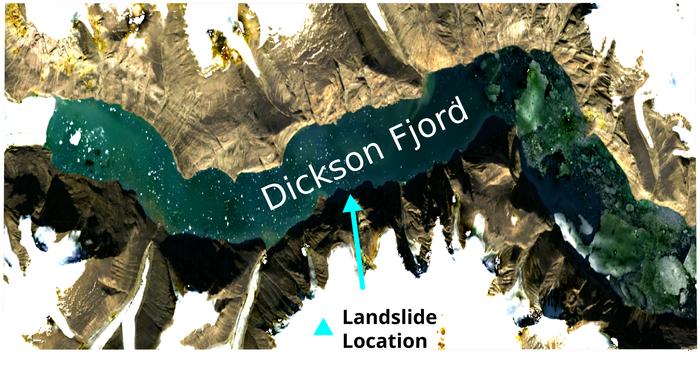Science
Scientists Capture First Images of Greenland’s Mega-Tsunami Seiches

In an unprecedented scientific breakthrough, researchers have captured the first images of seiches—standing waves generated by mega-tsunamis—following landslides in Dickson Fjord, Greenland. This discovery, confirmed by engineers at the University of Oxford, sheds light on seismic events that occurred in September and October 2023, when seismic detectors worldwide registered unusual signals every 90 seconds.
Initially, the cause of these tremors puzzled scientists. However, theoretical studies suggested that the vibrations were due to standing waves forming in the fjord after massive landslides triggered tsunamis. Using satellite altimetry data from the Surface Water Ocean Topography (SWOT) mission, the Oxford team successfully constructed detailed images of these seiches, confirming their origin from the landslide-induced mega-tsunamis.
Understanding the Impact of Seiches
The research team, co-led by Thomas Monahan, utilized SWOT’s capabilities to provide two-dimensional measurements of sea surface height with remarkable precision. This allowed them to observe the seiches in Dickson Fjord during the tumultuous events of September and October 2023. “It gave us an unprecedented view into Dickson Fjord during the seiche events,” Monahan said. By analyzing the high-resolution images, the team estimated that the water surface tilted significantly, revealing cross-channel slopes with height differences reaching up to two meters.
These features indicated that water was moving in both directions across the channel, a crucial finding in understanding the dynamics of the seiches. Monahan noted, “Finding the ‘seiche in the fjord’ was exciting, but the real challenge was proving that what we had observed was indeed a seiche and not something else.”
To validate their findings, the researchers approached the investigation methodically, ruling out alternative oceanographic phenomena. By correlating slope measurements with ground-based seismic data, they verified the characteristics of the seiches even during intervals when the satellite was not in position over the fjord.
Potential Climate Change Consequences
Although no one witnessed the seiches in action, the team estimates that the September seiche reached an initial height of 7.9 meters, while the October event measured approximately 3.9 meters. The force generated by these immense waves was equivalent to the power of 14 Saturn V rockets launching simultaneously, exerting around 500 GN. Monahan explained, “That amount of water sloshing back and forth creates an enormous force, literally enough to shake the entire Earth for days.”
The unique geometry of Dickson Fjord contributed to the intensity of these events. A sharp bend near the fjord’s outlet trapped the seiches, allowing them to reverberate for extended periods. This interaction caused water to continually strike the fjord walls, generating long-period seismic waves detectable across the globe.
Monahan suggested that climate change may play a significant role in increasing the frequency of such events. As glaciers recede, a process known as de-buttressing occurs, where the loss of ice weakens the surrounding rock, potentially leading to landslides. He warned, “As these events become more common, especially in steep, ice-covered terrain, the risk of tsunamigenic landslides will likely grow.”
The researchers aim to further investigate the dissipation of these seiches. Monahan stated, “Although previous work successfully simulated how the megatsunamis stabilized into seiches, how they decayed is not well understood.” Future research leveraging SWOT observations may provide insights into these processes.
The findings, published in Nature Communications, highlight the potential of advanced satellite missions like SWOT to enhance our understanding of complex oceanographic phenomena. To maximize these capabilities, researchers will require improved algorithms and techniques for interpreting the vast datasets generated by such missions. Monahan emphasized, “We think scientific machine learning will be extremely useful here.”
-

 Entertainment2 months ago
Entertainment2 months agoIconic 90s TV Show House Hits Market for £1.1 Million
-

 Lifestyle4 months ago
Lifestyle4 months agoMilk Bank Urges Mothers to Donate for Premature Babies’ Health
-

 Sports3 months ago
Sports3 months agoAlessia Russo Signs Long-Term Deal with Arsenal Ahead of WSL Season
-

 Lifestyle4 months ago
Lifestyle4 months agoShoppers Flock to Discounted Neck Pillow on Amazon for Travel Comfort
-

 Politics4 months ago
Politics4 months agoMuseums Body Critiques EHRC Proposals on Gender Facilities
-

 Business4 months ago
Business4 months agoTrump Visits Europe: Business, Politics, or Leisure?
-

 Lifestyle4 months ago
Lifestyle4 months agoJapanese Teen Sorato Shimizu Breaks U18 100m Record in 10 Seconds
-

 Politics4 months ago
Politics4 months agoCouple Shares Inspiring Love Story Defying Height Stereotypes
-

 World4 months ago
World4 months agoAnglian Water Raises Concerns Over Proposed AI Data Centre
-

 Sports4 months ago
Sports4 months agoBournemouth Dominates Everton with 3-0 Victory in Premier League Summer Series
-

 World4 months ago
World4 months agoWreckage of Missing Russian Passenger Plane Discovered in Flames
-

 Lifestyle4 months ago
Lifestyle4 months agoShoppers Rave About Roman’s £42 Midi Dress, Calling It ‘Elegant’









